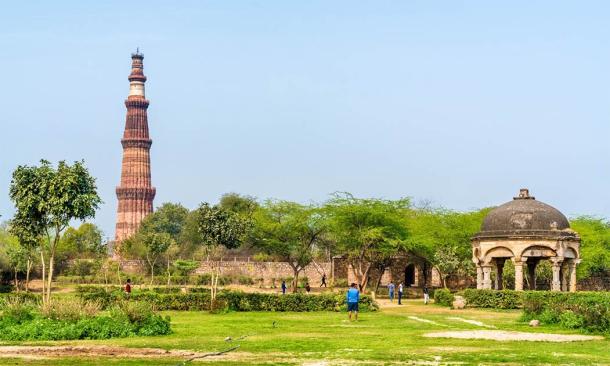
Qila Rai Pithora, the Ancient Fort That Gave Rise to Delhi
India’s many remarkable forts and citadels stand as a testament to its turbulent history. Qila Rai Pithora Hillfort in Delhi is one of the most impressive surviving fortresses in Northern India. This structure was crucial in the development of the city and it was occupied at times by both Hindu and Muslim garrisons. Today the fortress is a popular tourist site with well-preserved walls and structures.
An Overview of Qila Rai Pithora’s History
Although there are few written records regarding the fort, the earliest mention of it is found in a Mughal document written by a court historian in Persian. The early stronghold was known as Lal Kot and only later became known by its present name.
While no agreement has been reached regarding the fort’s origins, some archaeologists believe that parts of the fortress date to the 9 th century AD. This would imply that the fortress was built by the Tomara dynasty who ruled a large territory in Northern India between the 9 th and 11 th century. This is traditionally seen as the foundation of the first city of Delhi. Popular tradition attests that the Qila Rai Pithora Hillfort was built by the Chahamanas, a Rajput dynasty. It appears that they greatly extended the original fortress, but this is not proven.
The hillfort is named after the Chahamanas monarch, Prithviraja III (c. 1178–1192 AD), the most famous member of the dynasty whose memory is revered by many. He initially resisted Muslim invasions before he was defeated by the Ghurids, who later executed him.
Many historians doubt that Prithviraja built the hillfort or ever resided at the location. In 1192 AD, a Ghurid ruler occupied Qila Rai Pithora, and named it "Dilhi" (modern Delhi). This is widely seen as marking the beginning of the Delhi Sultanate. This powerful Muslim Empire controlled much of India and was ruled by five separate dynasties.
- Timurid Empire’s Arts and Culture Influenced Much of the Known World
- The Delhi Sultanate: 300 Years of Muslim Power Over the Indian Subcontinent
- Odd and Inexplicable Places in India Even Indians Don’t Know About!

The remains of Qila Rai Pithora’s mighty walls (CC BY 2.0)
The Ghurids and later dynasties extended the hillfort and it became part of the city’s extensive series of fortifications. It was occupied by a mainly Muslim garrison and played a key role in the defense of the Sultanate. It is thought to have been severely damaged by Timur in 1398 during the bloody sack of Delhi. Founder of the Timurid Dynasty, Timur was an undefeated commander, and regarded as one of the greatest military leaders and tacticians in history.
The hillfort was later occupied by the Mughals and was spared damage in some of the bloody battles and sieges that occurred during the decline and fall of the Mughal Empire. The Qila Rai Pithora is now a heritage site and its walls were restored in modern times.
The Ancient Remains of Qila Rai Pithora
The fort is located on a hill overlooking modern New Delhi and consist of two main parts, with Lal Kot being the oldest section of the stronghold. While this formed the citadel of the hillfort, only its outline and low walls are evident today.
The Qila Rai Pithora was oblong in shape, although some of its walls have been destroyed. It originally had seven gates with the Sohna gate located on a lake boasting a solar temple. Within the precincts, 27 Hindu and Jain temples were built. Sadly, only the stone walls and a number of round bastions can be seen.

Qutb Minar and Chhatri at the Quli Khan Tomb, Delhi (Leonid Andronov / Adobe Stock)
The site stretches for over several miles and a large area of South Delhi with parts of the fortress walls close to the famous Qutb complex, which has many spectacular remains from the Delhi Sultanate.
Today, the Rai Pithora Cultural Complex boasts an impressive statue of Prithviraja III. Ruins of buildings and temples consist of low stone walls, although remains of the gates to the hillfort can still be seen. The site is popular with locals and visitors as the numerous walkways in the hillfort are surrounded by beautiful gardens.
Visiting Qila Rai Pithora in Incredible India
The remains of the hillfort are located on the edge of New Delhi. They are easily accessible as they are situated near a major metro station. A fee is charged to enter the site and well worth the money as the walls can be walked for miles passing through beautiful scenery.
Top image: A statue of Prithviraja III at Qila Rai Pithora in Delhi Source: CC BY SA 3.0
By Ed Whelan
References
Cunningham, A. (1871). The ancient geography of India. Dalcassian Publishing Company
Available at: https://books.google.ie/books/about/The_Ancient_Geography_of_India.html?...
Hedger-Gourlay, F., Ingham, L., Newton, J., Tabor, E., & Worrell, J. (2006). Lal Kot and Siri
Available at: http://www.tabor.me.uk/places/sevencities/lalkot.pdf
Jalil, R., & Roy, P. (2008). Invisible city: the hidden monuments of Delhi. Niyogi Books















